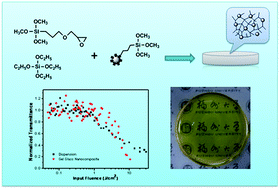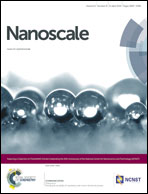Facile preparation of transparent and dense CdS–silica gel glass nanocomposites for optical limiting applications
Abstract
To realize their practical and operable applications as a potential optical limiting (OL) material, quantum dots (QDs) need to have good processability by incorporating them into optical-quality matrices. This work reports a facile route for the room-temperature preparation of large, stable transparent monolithic CdS nanocomposites which can be easily extended to allow the introduction of acid-sensitive functional molecules/nanoparticles into a silica network by sol–gel chemistry. Our strategy involves a two-step sol–gel process (acid-catalyst hydrolysis and basic-catalyst condensation) and the co-condensation of the resulting alkoxysilane-capped CdS QDs with other alkoxysilanes, which allows the CdS QDs to become part of the silica covalent network. The degradation and agglomeration of CdS QDs were thereby effectively restrained, and large monolithic transparent CdS–silica gel glass was obtained. Using Z-scan theory and the resulting open-aperture Z-scan curves, the nonlinear extinction coefficient of the CdS–silica nanocomposite gel glass was calculated to be 1.02 × 10−14 cm W−1, comparable to that of the parent CdS QD dispersion, indicating their promise for OL applications.

- This article is part of the themed collection: ChinaNANO

 Please wait while we load your content...
Please wait while we load your content...